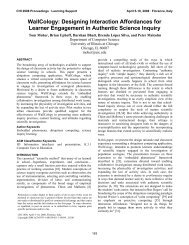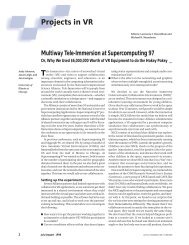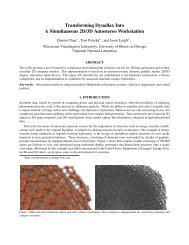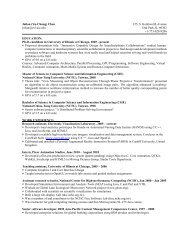The Future of the CAVE - Electronic Visualization Laboratory ...
The Future of the CAVE - Electronic Visualization Laboratory ...
The Future of the CAVE - Electronic Visualization Laboratory ...
You also want an ePaper? Increase the reach of your titles
YUMPU automatically turns print PDFs into web optimized ePapers that Google loves.
complex 3D objects. One participant wears a six degree-<strong>of</strong>-freedom location and orientation<br />
sensor called a tracker so that when he/she moves within <strong>the</strong> <strong>CAVE</strong>, correct viewer-centered<br />
perspective and surround stereo projections are produced quickly enough to give a strong sense <strong>of</strong><br />
3D visual immersion.<br />
Projection-based VR systems, such as <strong>CAVE</strong>s, feature surround viewing (ideally fully-surround,<br />
but usefully at least 90° in two dimensions such that users do not see <strong>the</strong> edges <strong>of</strong> <strong>the</strong> display).<br />
<strong>The</strong>y <strong>of</strong>fer stereo visuals. And, <strong>the</strong>y track <strong>the</strong> user to provide <strong>the</strong> correct scene perspective<br />
rendering in a continuous manner. Viewer-centered perspective and surround viewing distinguish<br />
VR systems from 3D movies.<br />
<strong>The</strong> classic <strong>CAVE</strong> was conceived and designed in 1991 by Tom DeFanti and Dan Sandin, who at<br />
<strong>the</strong> time were pr<strong>of</strong>essors and co-directors <strong>of</strong> <strong>the</strong> <strong>Electronic</strong> <strong>Visualization</strong> <strong>Laboratory</strong> (EVL) at <strong>the</strong><br />
University <strong>of</strong> Illinois at Chicago (UIC). Many students and colleagues over <strong>the</strong> years contributed<br />
to <strong>CAVE</strong> s<strong>of</strong>tware and hardware development, as seen in this paper’s many references.<br />
<strong>The</strong> goal <strong>of</strong> room-sized VR is to help scientists and engineers achieve scientific insight, and also<br />
to create a medium worthy <strong>of</strong> use by teachers, fine artists, architects, and archaeologists. <strong>The</strong><br />
most advanced classic <strong>CAVE</strong> to date, called Cornea, was installed in mid-2009 at <strong>the</strong> King<br />
Abdullah University <strong>of</strong> Science and Technology (KAUST) by Mechdyne Corporation<br />
[Mechdyne], and co-located with a new-generation <strong>of</strong> unique VR systems, designed by a team led<br />
by DeFanti, who is now at <strong>the</strong> California Institute for Telecommunications and Information<br />
Technology (Calit2) at University <strong>of</strong> California, San Diego (UCSD).<br />
<strong>CAVE</strong> participants see projected computer-generated stereo scenes but can also see <strong>the</strong>ir arms<br />
and bodies and can easily interact with one ano<strong>the</strong>r. <strong>The</strong> classic <strong>CAVE</strong> uses active stereo; <strong>the</strong><br />
rendering computers generate perspective views that are projected onto <strong>the</strong> walls for <strong>the</strong> left and<br />
right eyes <strong>of</strong> <strong>the</strong> primary participant in synchrony with electronic shutter glasses. <strong>The</strong> active<br />
eyewear is driven transparent in front <strong>of</strong> <strong>the</strong> left eye when <strong>the</strong> left eye image is projected, and<br />
opaque o<strong>the</strong>rwise; similarly, <strong>the</strong> right eye receives <strong>the</strong> right image. Images need to be generated<br />
at 96Hz (or higher) so each eye gets a flicker-free display. This is <strong>the</strong> way <strong>the</strong> new (2010)<br />
consumer 3D HDTVs work if <strong>the</strong>y use active shutter glasses. For successful active stereo, all<br />
screens must be synchronized so that each eye sees only <strong>the</strong> left or right stereo image on every<br />
screen at <strong>the</strong> same time, a requirement that is non-trivial as <strong>the</strong> number <strong>of</strong> screens and projectors<br />
increases; <strong>the</strong>refore, <strong>the</strong> underlying hardware and drivers must support synchronization.<br />
<strong>The</strong> classic <strong>CAVE</strong> uses rear-screen projection for <strong>the</strong> walls so <strong>the</strong> viewer does not cast shadows<br />
on <strong>the</strong> screens; however, as is <strong>of</strong>ten <strong>the</strong> case, when <strong>the</strong> floor is projected down from <strong>the</strong> top, <strong>the</strong><br />
projection creates a small shadow around participants’ feet. A <strong>CAVE</strong> with three walls and a floor<br />
minimally requires a 13m-by-10m space with a 4.5m high ceiling. Six-sided <strong>CAVE</strong>s (like<br />
KAUST’s Cornea and Iowa State’s C-6, as well as o<strong>the</strong>rs built in Gifu, Stockholm, and Stuttgart,<br />
for example) feature rear projection from every direction, requiring doubly higher ceilings and<br />
elaborate support structures, and bottom-projected floor screens made out <strong>of</strong> thick museum-style<br />
aquarium-grade acrylic plastic that can withstand <strong>the</strong> weight <strong>of</strong> 6-10 people. Projection-based<br />
<strong>CAVE</strong>s require significant (and o<strong>the</strong>rwise mostly wasted) rear-projection space, projectors<br />
costing $5,000-$500,000/screen, projector maintenance/alignment, lamp replacement, significant<br />
power and cooling, specialized screen material and controlled lighting conditions, all <strong>of</strong> which<br />
limit <strong>the</strong>ir acceptance and adoption in everyday workspaces, public venues, and homes. <strong>The</strong><br />
screen material itself must allow severe <strong>of</strong>f-axis viewing without objectionable intensity<br />
attenuation and, should minimize internal light spillage and reflection.<br />
(Head-mounted displays, which are ~1-2-inch screens mounted in some way in front <strong>of</strong> one’s<br />
eyes, are <strong>the</strong> earliest [Su<strong>the</strong>rland68] technology for single-user VR, and are well suited for in-<strong>the</strong>field<br />
and augmented (see-through) use. <strong>The</strong>y will not be fur<strong>the</strong>r discussed here since this article







